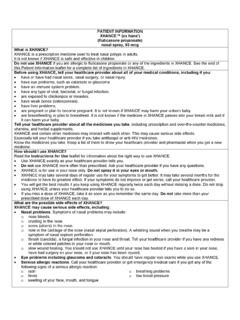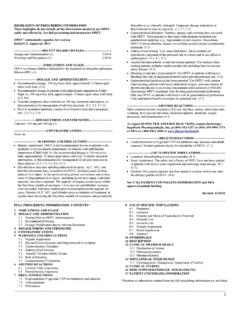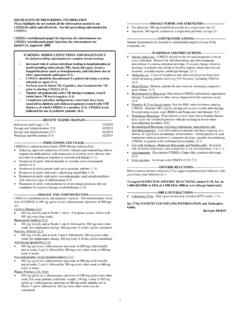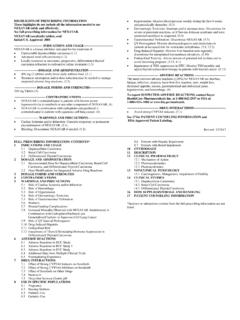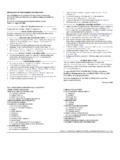Transcription of HIGHLIGHTS OF PRESCRIBING INFORMATION • These …
1 HIGHLIGHTS OF PRESCRIBING INFORMATION These HIGHLIGHTS do not include all the INFORMATION needed to use XHANCE safely and effectively. See full PRESCRIBING INFORMATION for XHANCE . XHANCE (fluticasone propionate) nasal spray, for intranasal use Initial Approval: 1994 ----------------------------INDICATIONS AND USAGE--------------------------- XHANCE is a corticosteroid indicated for the treatment of nasal polyps in patients 18 years of age or older. (1) ----------------------DOSAGE AND ADMINISTRATION----------------------- For intranasal use only. XHANCE is delivered into the nose by actuating the pump spray into one nostril while simultaneously blowing into the mouthpiece of the device. ( ) Recommended adult dosage: One spray per nostril twice daily (total daily dose of 372 mcg). Two sprays per nostril twice daily may also be effective in some patients (total daily dose of 744 mcg). ( ) ---------------------DOSAGE FORMS AND STRENGTHS---------------------- Nasal spray: 93 mcg of fluticasone propionate in each 106-mg spray.
2 (3) -------------------------------CONTRAIND ICATIONS------------------------------ Hypersensitivity to any ingredient in XHANCE. (4) -----------------------WARNINGS AND PRECAUTIONS------------------------ Local Nasal Effects: epistaxis, erosion, ulceration, septal perforation, Candida albicans infection, and impaired wound healing. Monitor patients periodically for signs of adverse effects on the nasal mucosa. Avoid use in patients with recent nasal ulcerations, nasal surgery, or nasal trauma. ( ) Close monitoring for glaucoma and cataracts is warranted. ( ) Hypersensitivity reactions ( , anaphylaxis, angioedema, urticaria, contact dermatitis, rash, hypotension, and bronchospasm) have been reported after administration of fluticasone propionate. Discontinue XHANCE if such reactions occur. ( ) Immunosuppression: potential increased susceptibility to or worsening of infections ( , existing tuberculosis; fungal, bacterial, viral, or parasitic infection; ocular herpes simplex).
3 Use with caution in patients with These infections. More serious or even fatal course of chickenpox or measles can occur in susceptible patients. ( ) Hypercorticism and adrenal suppression may occur with very high dosages or at the regular dosage in susceptible individuals. If such changes occur, discontinue XHANCE slowly. ( ) Assess for decrease in bone mineral density initially and periodically thereafter. ( ) ------------------------------ADVERSE REACTIONS------------------------------- The most common adverse reactions (incidence 3%) are epistaxis, nasal septal ulceration, nasopharyngitis, nasal mucosal erythema, nasal mucosal ulcerations, nasal congestion, acute sinusitis, nasal septal erythema, headache, and pharyngitis. ( ) To report SUSPECTED ADVERSE REACTIONS, contact OptiNose US, Inc. at 1-833-678-6673 and or FDA at 1-800-FDA-1088 or ------------------------------DRUG INTERACTIONS---------------------------- --- Strong cytochrome P450 3A4 inhibitors ( , ritonavir, ketoconazole): Use not recommended.
4 May increase risk of systemic corticosteroid effects. ( ) -----------------------USE IN SPECIFIC POPULATIONS------------------------ Hepatic impairment: Monitor patients for signs of increased drug exposure. ( ) See 17 for PATIENT COUNSELING INFORMATION and FDA-approved patient labeling. Revised: 09/2017_____ full PRESCRIBING INFORMATION : CONTENTS* 1 INDICATIONS AND USAGE 2 DOSAGE AND ADMINISTRATION Nasal Polyps Administration INFORMATION 3 DOSAGE FORMS AND STRENGTHS 4 CONTRAINDICATIONS 5 WARNINGS AND PRECAUTIONS Local Nasal Effects Glaucoma and Cataracts Hypersensitivity Reactions Including Anaphylaxis Immunosuppression Hypothalamic-Pituitary-Adrenal Axis Suppression Drug Interactions with Strong Cytochrome P450 3A4 Inhibitors Reduction in Bone Mineral Density Effect on Growth 6 ADVERSE REACTIONS Clinical Trials Experience 7 DRUG INTERACTIONS Inhibitors of Cytochrome P450 3A4 8 USE IN SPECIFIC POPULATIONS Pregnancy Lactation Pediatric Use Geriatric Use Hepatic Impairment Renal Impairment
5 10 OVERDOSAGE 11 DESCRIPTION 12 CLINICAL PHARMACOLOGY Mechanism of Action Pharmacodynamics Pharmacokinetics 13 NONCLINICAL TOXICOLOGY Carcinogenesis, Mutagenesis, Impairment of Fertility 14 CLINICAL STUDIES Nasal Polyps in Adults 18 Years of Age and Older 16 HOW SUPPLIED/STORAGE AND HANDLING 17 PATIENT COUNSELING INFORMATION *Sections or subsections omitted from the full PRESCRIBING INFORMATION are not listed. _____ full PRESCRIBING INFORMATION 1 INDICATIONS AND USAGE XHANCE nasal spray is indicated for the treatment of nasal polyps in patients 18 years of age or older. 2 DOSAGE AND ADMINISTRATION Nasal Polyps Adults (18 years and older): The recommended dosage of XHANCE nasal spray is 1 spray (93 mcg of fluticasone propionate per spray) in each nostril twice daily (total daily dose, 372 mcg).
6 A dose of 2 sprays (93 mcg of fluticasone propionate per spray) in each nostril twice daily may also be effective in some patients (total daily dose, 744 mcg). The maximum total daily dosage should not exceed 2 sprays in each nostril twice daily (total daily dose, 744 mcg). Patients should use XHANCE at regular intervals since its effectiveness depends on regular use. Individual patients will experience a variable time to onset and different degrees of symptom relief. The safety and efficacy of XHANCE when administered in excess of recommended doses have not been established. Administration INFORMATION Administer XHANCE by the intranasal route only, avoiding spraying directly on the nasal septum. Shake XHANCE before each use. Before initial use, prime XHANCE by first gently shaking and then pressing the bottle 7 times or until a fine mist appears. Direct the spray into the air, away from the face.
7 When XHANCE has not been used for 7 days, prime the pump again by shaking and releasing 2 sprays into the air, away from the face. XHANCE is delivered into the nose by actuating the pump spray into one nostril while simultaneously blowing (exhaling) into the mouthpiece of the device. To administer XHANCE, insert the tapered tip of the cone-shaped nosepiece deep into one nostril and form a tight seal between the nosepiece and the nostril. Next, place the flexible mouthpiece into the mouth, bending it as necessary to maintain a tight seal. Blow into the mouthpiece, and while continuing to blow, push the bottle up to actuate the spray pump. Continuing to blow through the mouth, but not inhaling or exhaling through the nose, at the time of actuation is important to achieve intended drug deposition. Repeat the process in the other nostril for a full dose. 3 DOSAGE FORMS AND STRENGTHS Nasal spray: Each 106-mg spray delivers 93 mcg of fluticasone propionate.
8 One unit provides 120 metered sprays. 4 CONTRAINDICATIONS XHANCE is contraindicated in patients with hypersensitivity to any of the ingredients [see Warnings and Precautions ( ) and Description (11)]. 5 WARNINGS AND PRECAUTIONS Local Nasal Effects Epistaxis, Nasal Erosions and Ulcerations In placebo-controlled clinical trials of 16 weeks duration, epistaxis, nasal erosions, and nasal ulcerations were reported more frequently in patients treated with XHANCE than those who received placebo [see Adverse Reactions ( )]. Nasal Septal Perforation Nasal septal perforations have been reported in patients following the intranasal application of XHANCE. In placebo-controlled clinical trials of 16 weeks duration, nasal septal perforations were reported in 1 ( ) patient treated with XHANCE compared with none treated with placebo. The patient had a prior history of nasal/sinus surgery. Three ( ) patients treated with XHANCE in uncontrolled, open-label trials of 3 to 12 months duration developed nasal septal perforations.
9 As with any long term topical treatment of the nasal cavity, patients using XHANCE over several months or longer should be examined periodically for possible changes in the nasal mucosa. If a septal perforation is noted, discontinue XHANCE. Avoid spraying XHANCE directly on the septum. Candida Infection In clinical trials with XHANCE, localized infections with Candida albicans have been observed. Eight ( ) patients in uncontrolled, open-label trials of 3 to 12 months duration developed Candida albicans infections (nasal, pharyngeal, esophageal or intestinal). If such an infection develops, it may require treatment with appropriate local therapy and discontinuation of XHANCE. Patients using XHANCE should be examined periodically for evidence of Candida infection in the nasal and oropharyngeal mucosa. Impaired Wound Healing Because of the inhibitory effect of corticosteroids on wound healing, patients who have experienced recent nasal ulcerations, nasal surgery, or nasal trauma should avoid using XHANCE until healing has occurred.
10 Glaucoma and Cataracts Nasal and inhaled corticosteroids, including flut icasone propionate, may result in the development of glauco ma and/or cataracts. In placebo-controlled clinical trials of 16 weeks duration, cataracts were reported in 4 ( ) patients treated with XHANCE, compared with 3 ( ) patients treated with placebo. Among These patients, 2 patients treated with XHANCE reported subcapsular cataracts compared with none treated with placebo. Eleven patients ( ) in uncontrolled, open-label trials of 3 to 12 months duration developed new or worsening cataracts, of which none were subcapsular. Therefore, close monitoring is warranted in patients with a change in vision or with a history of increased intraocular pressure (IOP), glaucoma, and/or cataracts. Hypersensitivity Reactions Including Anaphylaxis XHANCE is contraindicated in patients with known hypersensitivity to fluticasone propionate or any of the ingredients of XHANCE.
